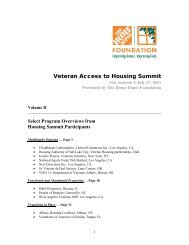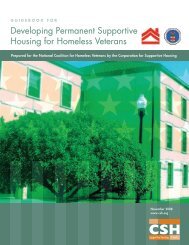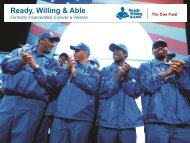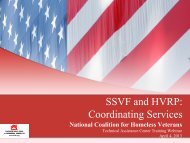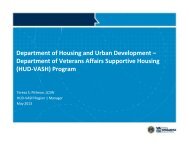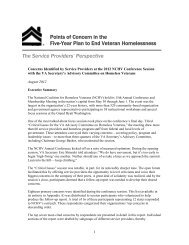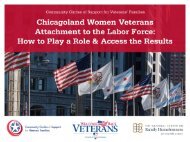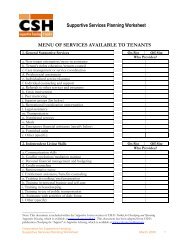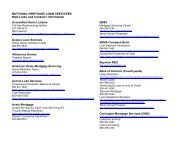here - National Coalition for Homeless Veterans
here - National Coalition for Homeless Veterans
here - National Coalition for Homeless Veterans
You also want an ePaper? Increase the reach of your titles
YUMPU automatically turns print PDFs into web optimized ePapers that Google loves.
HVRP <strong>Homeless</strong> Female <strong>Veterans</strong> and <strong>Homeless</strong> <strong>Veterans</strong> with Families:<br />
Current HFVVWF and HVRP Grantees<br />
May 23, 2013<br />
Presented by Baylee Crone, Vice President, Programs and Operations<br />
<strong>National</strong> <strong>Coalition</strong> <strong>for</strong> <strong>Homeless</strong> <strong>Veterans</strong> 1
Training Logistics<br />
• Date: May 23, 2013<br />
• Time: 3:00 p.m. – 4:00 p.m. EDT<br />
• Q&A at the end of the presentations<br />
• Hosted by: <strong>National</strong> <strong>Coalition</strong> <strong>for</strong><br />
<strong>Homeless</strong> <strong>Veterans</strong> Technical<br />
Assistance Center<br />
2
Logging In and Downloading Materials<br />
• To join by webinar: Within 10 minutes of the training's start time, log<br />
in <strong>here</strong>: http://lotuslive.readyshow.com using the following participant<br />
code: 26432122. You will be able to hear the audio of the call through<br />
your computer, or you can listen to the audio over the phone by dialing<br />
1-877-366-0711 and providing the operator with the following<br />
participant code: 26432122.<br />
• To join by phone only (not using webinar plat<strong>for</strong>m): Please dial 1-<br />
877-366-0711 within 10 minutes of the training's start time and provide<br />
the operator with the following participant code: 26432122.<br />
• Materials <strong>for</strong> this training will be available <strong>here</strong>:<br />
http://nchv.org/index.php/service/service/teleconference/<br />
• If you are having difficulties logging in, please try again or contact<br />
Baylee Crone at bcrone@nchv.org.<br />
3
Asking Questions During the Training<br />
• Submit questions in the chat box<br />
on the webinar<br />
• E-mail questions to Baylee<br />
Crone at bcrone@nchv.org<br />
• Submit questions through the<br />
post-training survey (received<br />
tomorrow morning)<br />
4
Agenda<br />
1. Overview of the HVRP Application<br />
2. Overview of the Application Process<br />
3. Changes to the SGA<br />
4. Additional Resources<br />
5
1. Overview of the HVRP Application<br />
6
Background In<strong>for</strong>mation<br />
• Authorization and Administration<br />
• Section 2021 of Title 38 of the United States Code (U.S.C.) requires the<br />
Secretary of Labor “to conduct, directly or through grant or contract, such<br />
programs as the Secretary determines appropriate to provide job training,<br />
counseling, and placement services (including job readiness, literacy training,<br />
and skills training) to expedite the reintegration of homeless <strong>Veterans</strong> into the<br />
labor <strong>for</strong>ce.”<br />
• Funds available under 38 USC Section 2012A<br />
• Honoring America’s <strong>Veterans</strong> and Caring <strong>for</strong> Camp Lejeune Families Act of<br />
2012 (Public Law 112-154) signed by President Barack Obama on August 6,<br />
2012<br />
• More in<strong>for</strong>mation:<br />
http://nchv.org/index.php/news/headline_article/bill_to_reauthorize_impro<br />
ve_critical_homeless_veteran_programs_headed_to_pr/<br />
• Section 305 reauthorizes HVRP through Fiscal Year 2013<br />
•<br />
7
Objectives of the Program<br />
• Main program objectives<br />
• To provide services to assist in reintegrating homeless female veterans and<br />
veterans with families into meaningful employment within the labor <strong>for</strong>ce<br />
and;<br />
• To stimulate the development of effective service delivery systems that<br />
will address the complex problems facing homeless female veterans and<br />
veterans with families.<br />
8
“Rules of Three”<br />
• Must meet operational,<br />
administrative, and<br />
financial requirements<br />
• Goals and strategies<br />
must create positive<br />
training, employment<br />
and retention outcomes<br />
• Complete,<br />
comprehensive, and<br />
co<strong>here</strong>nt narratives<br />
<strong>National</strong>/Universal<br />
Regional/State<br />
Local/<br />
Tribal<br />
9
Case Management Model Development<br />
• Important considerations<br />
• Housing<br />
• Organizational experience<br />
• Medical care/mental health care<br />
• Benefits navigation<br />
• Legal services<br />
• Child care services<br />
• MOUs whenever possible!<br />
10
General Application In<strong>for</strong>mation<br />
• Solicitation <strong>for</strong> Grant Applications (SGA)<br />
• Funding Opportunity Number:<br />
• SGA #13-02 / PY 2013<br />
• Catalog of Federal Domestic Assistance (CFDA)<br />
Number:<br />
• 17.805<br />
• Changes/Amendments to the SGA<br />
• Check back regularly to www.grants.gov and the DOL-VETS website<br />
• Applicant responsibility to check back on these!!<br />
11
First Round of HFVVWF in PY 2010<br />
• Program Year 2010 SGA<br />
• Program funded grants from July 1, 2010-June 30,<br />
2013<br />
• One year of funding with two option years of renewal<br />
funding<br />
• 26 grantees awarded<br />
• 21 current grantees<br />
12
Current SGA Funding Levels and Categories<br />
• Funding Levels:<br />
• $5 million total<br />
• Distributed between Urban and Non-Urban<br />
• Urban: $100,000 – $300,000<br />
• Non-Urban: $100,000 - $200,000<br />
• Do not go outside of these ranges!!<br />
• Native American tribal lands are non-urban (p.2)<br />
• Funding Category:<br />
• Clearly identify your funding category!<br />
• Urban or Non-Urban: Appendix G<br />
• metropolitan statistical areas (MSA)<br />
• 75 largest cities from 2010 US Census<br />
• The proposed area to be served has a population of at least 698,030<br />
• Provide documentation and maps <strong>for</strong> your funding category<br />
13
Per<strong>for</strong>mance Period<br />
• Per<strong>for</strong>mance period: 12 months; July 1, 2013-June 30,<br />
2014<br />
• Follow-up <strong>for</strong> 3 quarters: July 1, 2014-March 31, 2015<br />
• Program funds obligated and reserved <strong>for</strong> 9 months of follow<br />
up and close out by June 30, 2014<br />
• Must be able to begin program activities on day 1 (July 1) of<br />
grant award<br />
• Must be fully staffed and operational within 30 days<br />
notification of award<br />
• One year grants<br />
• Up to three renewal years (See VPL#02-12)<br />
14
Eligible Applicants<br />
• Applicant Eligibility<br />
• State and local Work<strong>for</strong>ce Investment Boards (SWIBs/LWIBs)<br />
• Local public agencies<br />
• Native American tribal governments (federally recognized)<br />
• Native American tribal organizations (other than federally<br />
recognized tribal governments)<br />
• For-profit/commercial entities<br />
• Non-profit organizations<br />
• Community-based organizations<br />
• Faith-based organizations<br />
• Must have IRS documentation of 501 (c)(3) status!!<br />
15
Eligible Service Population<br />
• Three important definitions:<br />
• Veteran, veteran family, and homeless<br />
• Definition 1: Veteran:<br />
• a person who served in the active military, and<br />
• who was discharged or released under conditions other than dishonorable<br />
• <strong>Veterans</strong> with dishonorable discharge are NOT eligible <strong>for</strong> HFVVWF<br />
• Definition 2: Veteran Family:<br />
• A person who is a veteran as specified and who has been designated as or<br />
is the primary caretaker of any dependent children under the age of 18<br />
• For additional details, see 38 USC 101 – Sec. 101<br />
16
Eligible Service Population<br />
• Definition 3: <strong>Homeless</strong>:<br />
• 1. persons who lack a fixed, regular, and adequate nighttime residence<br />
• 2. persons living in supervised public or privately operated shelter designed to<br />
provide temporary living arrangements<br />
• 3. an individual who resided in a shelter or place not meant <strong>for</strong> human habitation and<br />
who is exiting an institution w<strong>here</strong> he or she temporarily resided<br />
• 4. persons with a primary nighttime residence that is a public or private place not<br />
designed <strong>for</strong> or ordinarily used as a regular sleeping accommodation <strong>for</strong> human<br />
beings<br />
• Also includes:<br />
• an individual or family who will imminently lose their housing, can identify no subsequent<br />
residence, and which lacks the resources or support networks needed to obtain other<br />
permanent housing.<br />
• unaccompanied youth and homeless families with children and youth defined as homeless<br />
under other Federal statutes (see p. 13 <strong>for</strong> more in<strong>for</strong>mation)<br />
17
Additional Important Definitions<br />
• Chronically homeless:<br />
• Unaccompanied homeless individual with a disabling condition who has either<br />
been continuously homeless <strong>for</strong> a year or more, or who has had at least four (4)<br />
episodes of homelessness in the past three (3) years.<br />
• Disabling condition:<br />
• Diagnosable substance abuse disorder, serious mental illness, developmental<br />
disability, or chronic physical illness or disability including the co-occurrence of<br />
two or more of these conditions.<br />
• Proprietary or business confidential in<strong>for</strong>mation:<br />
• Not usually disclosed outside your organization<br />
• Could cause your organization substantial competitive harm<br />
• Personally Identifiable in<strong>for</strong>mation (PII):<br />
• Can be used to trace an individual’s identity<br />
• Linked to an individual (medical, educational, financial, employment)<br />
• See OMB Memorandum 07-16 and 06-19<br />
18
Components of the Application<br />
• Three Sections:<br />
• I. Cost Proposal<br />
• II. Technical Proposal<br />
• III. Attachments to the Technical Proposal<br />
19
Components of the Application<br />
• Part I: Cost Proposal (No points)<br />
• **Must provide all of these documents!!<br />
• SF-424 (Appendix A)<br />
• Catalog of Federal Domestic Assistance #17.805<br />
• DUNS #<br />
• Budget In<strong>for</strong>mation Form SF-424A (Appendix B)<br />
• Budget Narrative<br />
• Assurances and Certifications Signature Page (Appendix C)<br />
• Direct Cost Description <strong>for</strong> Applicants and Sub-applicants (Appendix E)<br />
• Indirect Charges or Certificate of Direct Costs Form (Appendix I)<br />
• Register with System <strong>for</strong> Award Management (SAM) (<strong>for</strong>merly CCR)<br />
20
Components of the Application<br />
• Part III: Attachments to the Technical Proposal<br />
• Abstract<br />
• Overall strategy<br />
• Timeline<br />
• Outcomes<br />
• Geographic area to be served<br />
• PY 2013 Competitive Grants Planned Goals Chart (Appendix D)<br />
• Audit summary<br />
• Employment and Training Grants<br />
• Survey on Ensuring Equal Opportunity <strong>for</strong> Applicants (Appendix F)<br />
• Project/Per<strong>for</strong>mance Site Location Form OMB Number 4040-0010 (Appendix L)<br />
• Contracts and MOUs<br />
• Organizational and staff resumes/capacity documents<br />
• Statement of intent to work collaboratively with DOL and contractor<br />
21
Components of the Application<br />
• Part II: Technical Proposal (100 Points)<br />
• 15 pages maximum<br />
• Major Components:<br />
• Need <strong>for</strong> the Project (10)<br />
• Overall Approach or Strategy (45)<br />
• Outreach (10 pts.)<br />
• Assessment & Intake (10 pts.)<br />
• Employment & Training Services (15 pts.)<br />
• Follow-up Services (10 pts.)<br />
• Quality of Linkages (15)<br />
• Organizational and Staff Capacity (20)<br />
• Housing Strategy (10)<br />
22
Technical Proposal<br />
• Need <strong>for</strong> the Project (10 points)<br />
• Description of service area<br />
• Identify category (urban or non-urban)<br />
• Identify congressional district and Native American tribal region, if<br />
applicable<br />
• Major components<br />
• Numbers of homeless female veterans and veterans with families,<br />
compared to national data and local homelessness data<br />
• Poverty and unemployment<br />
• Gaps in supportive service delivery system<br />
• Employment barriers of homeless female veterans and veterans<br />
with families<br />
• Local labor market in<strong>for</strong>mation and trends<br />
23
Technical Proposal<br />
• Overall Approach and Strategy (45 points)<br />
• Focus on:<br />
• Understanding of challenges<br />
• Connectivity to appropriate service provider networks<br />
• Descriptive approach to providing comprehensive services<br />
• Dimensions:<br />
• Outreach<br />
• Assessment and Intake<br />
• Employment and Training<br />
• Follow-up Services<br />
24
Technical Proposal:<br />
Overall Approach and Strategy Section<br />
• Dimension 1: Outreach (10 points)<br />
• Tailored, targeted outreach is important<br />
• Make ef<strong>for</strong>ts to avoid duplication<br />
• Types of activities:<br />
• Project orientation workshops<br />
• Provider meetings<br />
• Create <strong>for</strong>mal MOUs or service contracts<br />
25
Technical Proposal:<br />
Overall Approach and Strategy Section<br />
• Dimension 2: Assessment and Intake (10 points)<br />
• Identify and address barriers to employment <strong>for</strong> participants to<br />
ensure long-term success<br />
• Describe your timing and process<br />
• Major components:<br />
• Assess barriers to employment<br />
• Assessing abilities, interests, needs<br />
• Determining veteran willingness<br />
• Connecting to services (be<strong>for</strong>e, during, and after enrollment)<br />
• Connecting to and tracking outcomes <strong>for</strong> VA benefits<br />
26
Technical Proposal:<br />
Overall Approach and Strategy Section<br />
• Dimension 3: Employment and Training Services (15 points)<br />
• Develop <strong>for</strong>mal service plans and manage and track progress<br />
• 1- year timeframe<br />
• 80% of enrolled participants must engage in job skills training<br />
• Major components:<br />
• Individual Employment Plan (IEP)<br />
• Process <strong>for</strong> developing and updating<br />
• All employment and training services<br />
• All life skills training<br />
• Relationship with AJC<br />
• Referral timing and process with AJC<br />
• Job and Training opportunities<br />
• Locally in demand<br />
• Career growth<br />
• Sufficiently high wages<br />
• Local Training and employment network<br />
• Training<br />
• Length, curriculum, and impact<br />
• Show usage of different training services<br />
27
Technical Proposal:<br />
Overall Approach and Strategy Section<br />
• Dimension 4: Follow-up Services (10 points)<br />
• Must track <strong>for</strong> three quarters after placement<br />
• Utilize creative approaches and incentives <strong>for</strong> follow-up<br />
• If using State Unemployment Insurance to track participants,<br />
be sure to have a signed MOU with your application<br />
• Do not <strong>for</strong>get Appendix D!!<br />
28
Technical Proposal<br />
• Quality of Linkages (15 points)<br />
• T<strong>here</strong> will likely be duplications with previous section<br />
• Show engagement and connection with various federal,<br />
state, and local programs, including:<br />
• CoC programs<br />
• Local 10 year plans to end homelessness<br />
• Other listed Federal programs<br />
29
Technical Proposal<br />
• Quality of Linkages (cont.)<br />
• In<strong>for</strong>mation about your linkages:<br />
• Who the partner is<br />
• Their funding source<br />
• The type of referral system<br />
• Whether it is a proposed or an established linkage<br />
• HFVVWF specific partners:<br />
• Housing<br />
• Medical and mental health care services<br />
• VARO <strong>for</strong> benefits<br />
• Legal services<br />
• Child care<br />
30
Technical Proposal<br />
• Organizational Capacity and Experience (20 points)<br />
• Address sustainability and start-up issues<br />
• Staff experience and organization experience:<br />
• Staff: see page 54-55<br />
• Organization experience:<br />
• Previous HVRP or HFVVWF grantees<br />
• most recently completed 4th quarter Technical Per<strong>for</strong>mance<br />
Report (TPR)<br />
• most recently completed 4th quarter Technical Per<strong>for</strong>mance<br />
Narrative (TPN)<br />
• planned goals spreadsheet the year the of the most recently<br />
completed 4 th quarter report<br />
• No HVRP or HFVVWF experience:<br />
• most recent three year periods of financial and programmatic<br />
cumulative final year end per<strong>for</strong>mance reports<br />
• summary narrative of program experience and a descriptive<br />
showing the program’s employment and training per<strong>for</strong>mance<br />
outcomes<br />
31
Technical Proposal<br />
• Housing Strategy (10 points)<br />
• Strategy must include emergency, temporary, transitional,<br />
permanent supportive, and af<strong>for</strong>dable housing resources<br />
• Show how you will match housing needs to the veteran<br />
• Provide/ connect to appropriate housing <strong>for</strong> the number of<br />
planned enrollees<br />
• DO NOT use HVRP funds <strong>for</strong> housing, rent, deposits, or<br />
vehicle payments<br />
• Show your knowledge of the HUD-VASH process,<br />
including eligibility<br />
32
2. Overview of the Application Process<br />
33
Page Limits and Formatting<br />
• Page limits<br />
• 50 page total page limit<br />
• 15 page maximum on Technical Proposal<br />
• Formatting<br />
• Single-sided pages, 8-1/2” x 11” inch paper, double spaced, 12<br />
pt. font, 1 inch margins, English<br />
• (if submitting through grants.gov) .doc, .rtf., .pdf <strong>for</strong>mat<br />
• Consecutively number pages<br />
• Tab dividers <strong>for</strong> sections and sub-sections<br />
34
Application and Funding Restrictions<br />
• Application restrictions<br />
• 1 application per submitting organization and physical location with same<br />
hfvvwf population<br />
• NO co-enrollment of participants in HFVVWF and VWIP<br />
• Funding restrictions<br />
• Admin costs not to exceed 20% of total award<br />
• No pre-award costs<br />
• Salary and bonuses cannot go beyond Executive Level II<br />
• No participant wages from the grant, but funding can be used <strong>for</strong><br />
reasonable cost of providing OJT<br />
35
Application Submission<br />
• Due dates<br />
• 30 days after publication of the SGA: 4:00 p.m. Eastern June 14, 2013<br />
• NO LATE APPLICATIONS<br />
• Acceptable methods of submission<br />
• US Mail<br />
• Overnight delivery<br />
• hand delivery<br />
• www.grants.gov<br />
• Unacceptable methods of submission<br />
• E-mail<br />
• Telegram<br />
• Fax<br />
• Multiple application submissions<br />
• If you submit both, send a hard-copy letter<br />
• If t<strong>here</strong> is no letter, then the last qualifying submission through grants.gov will be<br />
accepted<br />
36
Application Submission<br />
• If you are mailing your application<br />
• Submit original signed in blue ink<br />
• 2 copies must be “Copy ready”<br />
• Need a CD that is identical<br />
• Address <strong>for</strong> mailing:<br />
• U.S. Department of Labor, Procurement Services Center<br />
• Attention: Cassandra Mitchell, Reference SGA #13-02<br />
• 200 Constitution Avenue NW, Room S-4307<br />
• Washington, DC 20210<br />
• If you are using grants.gov<br />
• “Get Registered” can take up to 4 weeks<br />
• No copies are needed<br />
• Be sure to create an Authorized Organizational Representative (OAR)<br />
• Download the registration checklist<br />
• Two e-mails received after submission<br />
• 1- confirms receipt; tracking #<br />
• 2- confirms rejection due to errors or validation<br />
37
Components of the Application<br />
• NOT Included in 50 Page Proposal Maximum<br />
• Organizational chart<br />
• Staff resumes<br />
• Detailed staff capacity statements<br />
• TPN (or comparable documents <strong>for</strong> non-HVRP/HFVVWF)<br />
• TPR (or comparable documents <strong>for</strong> non-HVRP/HFVVWF)<br />
• Past per<strong>for</strong>mance planned goals spreadsheet (or comparable documents <strong>for</strong> non-<br />
HVRP/HFVVWF)<br />
• Urban/non-urban maps and written documentation<br />
• IRS statement showing 501 (c) 3 status<br />
• MOUs<br />
• Audit summary<br />
• PY 2013 Competitive Grant Planned Goals (Appendix D)<br />
38
Components of the Application<br />
• NOT Included in 15 Page Technical Proposal Maximum<br />
• Abstract/Executive Summary<br />
• Participant flow chart<br />
• Employer and training network list<br />
• Organizational chart<br />
• Staff resumes<br />
• Staff capacity statements<br />
• TPN (or comparable documents <strong>for</strong> non-HVRP/HFVVWF)<br />
• TPR (or comparable documents <strong>for</strong> non-HVRP/HFVVWF)<br />
• Past per<strong>for</strong>mance planned goals spreadsheet (or comparable documents <strong>for</strong> non-<br />
HVRP/HFVVWF)<br />
• Past employment and training grants list, with contact in<strong>for</strong>mation<br />
• PY 2013 Competitive Grant Planned Goals (Appendix D)<br />
• Urban/Non-urban maps and written documentation<br />
• Survey on Ensuring Equal Opportunity <strong>for</strong> Applicants (Appendix F)<br />
• MOUs<br />
• Audit summary<br />
• Project/Per<strong>for</strong>mance Site Location Form OMB Number 4040-0010 (Appendix L)<br />
39
Application Submission<br />
Remember….<br />
Include all requested documents, or your application will not be<br />
graded!!<br />
40
Grading Applications and Announcement of Awards<br />
• Award announcements<br />
• Grants will likely be made in both funding categories<br />
• Number of awards dependent on applications<br />
• Award announcement process<br />
• Initial acceptance<br />
• Negotiations with grant office (potentially)<br />
• Final award OR termination of process/termination of award/decline to fund<br />
• Application grading process<br />
• Will begin following close of open grant period<br />
• Merit-based awards<br />
41
Transparency<br />
• VETS may published the following components of your<br />
application publicly<br />
• On DOL-VETS website or similar location<br />
• Abstract<br />
• No redactions<br />
• Published upon award<br />
• Technical Proposal<br />
• Must be received in 2 weeks or only PII is removed<br />
• Further direction upon grant award<br />
• Instruction received by e-mail or letter<br />
• Published upon receipt of redacted version<br />
• SF-424<br />
42
3. Changes to the SGA<br />
43
Changes<br />
• Structure of the application<br />
• Three major components of the application: Cost Proposal, Technical Proposal, and<br />
Attachments (was Executive Summary, Technical Proposal, and Cost Proposal)<br />
• Page limitations: 50 pages total (was 75 pages total)<br />
• Acceptable documents <strong>for</strong> online submission through grants.gov: only .doc, .rtf., .pdf<br />
(previously, .rtf was not included but xls was)<br />
• SGA#: 13-02 (was 10-03)<br />
• Data sources<br />
• Updated Census: 2010 Census (was 2000 Census)<br />
• Updated MSA/75 largest cities: 698,030 (was 569,463)<br />
• Eligibility<br />
• (Participant) Expanded definition of homelessness: HEARTH definition, to include those<br />
“eminently at risk” (see previous SGA <strong>for</strong> full old definition)<br />
• (Participant) Additional in<strong>for</strong>mation on definition of “veteran with families”: See 38 USC 101<br />
– Sec. 101<br />
• (Participant) Service priorities have been removed<br />
• (Applicant) Now, Native American tribal governments and organizations, including Federally<br />
and other than Federally recognized tribal lands, are eligible to apply (were not included<br />
previously)<br />
44
Changes<br />
• Technical Proposal<br />
• Career One Stops are now American Job Centers<br />
• Outreach: no requirement that AJCs be part of outreach plan (previously, this was a<br />
requirement)<br />
• No requirement that small CBOs be incorporated into outreach plan (previously,<br />
this was strongly suggested)<br />
• No need to register as an EN (previously, this was suggested)<br />
• No need to focus on connecting to universities with history of high enrollment of<br />
minority students (previously, this was suggested)<br />
• No focus on green jobs (previously, this was required)<br />
• Specific and detailed housing strategy <strong>for</strong> number of participants<br />
• Need <strong>for</strong> the project: include in<strong>for</strong>mation on local labor market (previously, this was<br />
not included)<br />
• No additional points: No additional points given <strong>for</strong> “innovative approach”<br />
• Cost proposal<br />
• MUST have an audit summary (previously, financial statements and/or an audit was<br />
required)<br />
• See SGA <strong>for</strong> full list of cost proposal documents<br />
45
Changes<br />
• Funding<br />
• Funding amounts: up to 5 million (previously, up to 3 million <strong>for</strong> urban, 3 million <strong>for</strong> nonurban)<br />
• Funding brackets: 100K-200K Non-urban; 100K-300K Urban. Do not go outside of these<br />
ranges (previously, minimum was 75K with no restriction against requesting less than 75K)<br />
• Future funding years: Must meet 85% of planning cumulative quarterly goals to be eligible <strong>for</strong><br />
future funding years (was 90%)<br />
• Option years: up to three option years (previously, only two available)<br />
• Sub-grantees<br />
• DUNS #: sub-grantees must have and provide you with their DUNs# (previously, this was not<br />
mentioned)<br />
• Reporting<br />
• Guidance on reporting: See VPL (previously, this in<strong>for</strong>mation was included in the SGA)<br />
• Other<br />
• Registering: Register with SAM (previously, CCR)<br />
• Past per<strong>for</strong>mance <strong>for</strong> HVRPs: Include TPR, TPN, and planned goals (previously, only TPR)<br />
• Submission time: submit by 4:00 p.m. Eastern (was 5:00 p.m. Eastern)<br />
• No post award conference: do not include this in your budget<br />
46
4. Additional Resources<br />
47
Additional Resources<br />
<br />
<br />
Application in<strong>for</strong>mation:<br />
DUNS Number: www.dunandbradstreet.com; 866-705-5711<br />
Applying online: http://www.grants.gov/applicants/get_registered.jsp;<br />
Issues with Grants.gov: 800-518-4726 or support@grants.gov<br />
Organization registration checklist:<br />
www.grants.gov/assets/Organization_Steps_Complete_Registration.pdf<br />
SAM: http://www.grants.gov/applicants/org_step2.jsp<br />
NCHV Website: www.nchv.org<br />
NVTAC Websie: http://bbi.syr.edu/nvtac/<br />
Helpful application resources:<br />
Community organizations: http://www.nchv.org/network.cfm<br />
ICH in<strong>for</strong>mation: http://www.usich.gov/usich_resources/maps/overall_homelessness_rates<br />
Continuum of Care in<strong>for</strong>mation: http://www.hudhre.info/index.cfm?do=viewCocMaps<br />
Healthcare <strong>for</strong> <strong>Homeless</strong> <strong>Veterans</strong> Program Guide:<br />
http://www.va.gov/HOMELESS/docs/HCHV_Sites_ByState.pdf<br />
Employment Resources: http://www.nchv.org/page.cfm?id=241<br />
Mileage rates: www.gsa.gov<br />
Career One Stop in<strong>for</strong>mation: http://servicelocator.org/<br />
State Unemployment Insurance:<br />
http://work<strong>for</strong>cesecurity.doleta.gov/unemploy/uifactsheet.asp<br />
48
Additional Resources (cont.)<br />
<br />
<br />
Useful Publications:<br />
Best Practices of HVRP:<br />
http://www.nchv.org/images/uploads/HVRP_Best_Practices_Vol._2_WEB_.pdf<br />
Best Practices: Housing:<br />
http://www.nchv.org/images/uploads/Best%20Practices%20<strong>for</strong>%20HVRP%20Grantees_Hous<br />
ing%20Services_WEB(1).pdf<br />
Serving Female <strong>Veterans</strong>: http://www.nchv.org/images/uploads/HFV%20paper.pdf<br />
Employment Assistance Guide: http://www.nchv.org/docs/EAG%201-10.pdf<br />
Opening Doors:<br />
http://www.usich.gov/resources/uploads/asset_library/Opening%20Doors%202010%20FINA<br />
L%20FSP%20Prevent%20End%20<strong>Homeless</strong>.pdf<br />
VA <strong>Homeless</strong> Resource Guide:<br />
http://www.va.gov/HOMELESS/docs/<strong>Homeless</strong>_Resource_Guide.pdf<br />
Federal Program Sites:<br />
USICH Website: http://www.usich.gov/<br />
CHALENG In<strong>for</strong>mation: http://www.va.gov/homeless/chaleng.asp<br />
Bureau of Labor and Statistics: http://www.bls.gov/<br />
O*NET: http://www.onetonline.org/<br />
My next move: http://www.mynextmove.org/vets/<br />
Congressional Districts:<br />
https://www.federalreporting.gov/federalreporting/congressionalDistricts.do<br />
49
Contact In<strong>for</strong>mation<br />
For questions regarding the SGA: Cassandra<br />
Mitchell, Grant Officer, at (202)693-4570 (this is<br />
not a toll-free number) or by e-mail at<br />
mitchell.cassandra@dol.gov<br />
For HVRP Technical Assistance and questions<br />
about this presentation: Baylee Crone, NCHV, at<br />
(202) 546-1969 or by e-mail at bcrone@nchv.org<br />
50
Asking Questions<br />
• Submit questions in the chat box<br />
on the webinar<br />
• E-mail questions to Baylee<br />
Crone at bcrone@nchv.org<br />
• Submit questions through the<br />
post-training survey (received<br />
tomorrow morning)<br />
51



